FRUIT HARVEST, WHEN?
/7 Comments/in Fruit, Gardening, Pests/by Lee ReichEasy to Grow, Hard to Harvest
Of all commonly grown tree fruits, pears are the easiest, mostly because they succumb to fewer pest and weather problems than do other common tree fruits. Of all commonly grown tree fruits, pears are the most difficult to harvest.
Timing is what makes pears so difficult to harvest, a skill I’m ashamed to admit I have yet to master. You can’t time when to pick by taste because pears are among the few fruits that will not ripen well on the tree. They start ripening from their innards outward so by the time the outside of the fruit looks and feels ripe, the innards are brown mush.
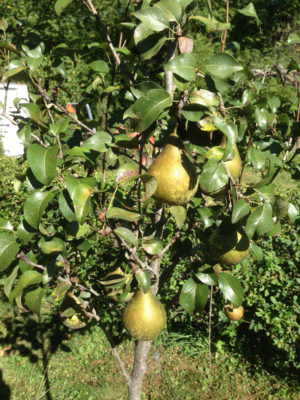
Concorde European pear, ripe?
No need to refer me to the guidelines of experts: The skin should undergo an almost imperceptible change in color, lightening or yellowing. The fruit softens ever so slightly, going from the firmness of a basketball to that of a softball. The fruit stalk separates readily from the stem when the fruit is lifted and given a slight twist. And finally, in my opinion the most obtuse indicator, lenticels (small pores on the skin) change from white and raised to brown and shallow. Yadda, yadda, yadda, . . .
I grow about 20 varieties of pear, and each of those very subtle indicators are slightly different for one variety to the next.
Another of my excuses is that most of my varieties are just beginning to bear so I don’t have a lot of fruits from each tree to play around with. I am adept at harvesting those varieties — Magness, Seckel, Harrow Delight — that have borne the most fruit for the most years.
Easy to Grow, Easy to Harvest
Ah, but my horticultural shortcomings don’t extend to all pears. I also grow a few varieties of Asian pears, which differ from the aforementioned and more common European pears in being usually round and of a few different species. Most significantly, Asian pears will ripen to perfection on the tree. In fact, for best flavor, they must remain hanging until dead ripe, at which point they have a “cracking” texture, that is, they are crisp but explode in your mouth with their sweet, ambrosial juice.
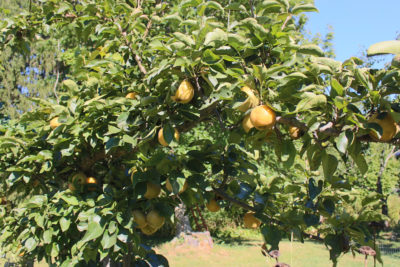
Yoinashi Asian pear
The skin of Chojuro, the earliest of my Asian pears, started changing from brown russet to golden yellow russet earlier this month. As a further check to ripeness, I picked a fruit and sunk my teeth into it. Delicious! They’re ripe and hang in good condition to be plucked from the branches, as needed, for a week or two, or they can be harvested in toto and refrigerated. The varieties Yoinashi and Seuri Li will follow shortly here, with Korean Giant following these two varieties next year, when it comes into bearing.
Asian pears are as easy, perhaps even easier, to grow than European pears. They bear at a young age and heavily, often too young and too heavily, which is why it’s necessary to grit your teeth and aggressively thin the fruits. Too heavy a crop stunts young trees or spells small, less flavorful fruits on grown trees. (I devote a whole chapter to Asian pears in my book Uncommon Fruits for Every Garden.)
And Then There are Grapes
Grapes . . . they’re easy to harvest ripe. Except that most people don’t. Color is but one indicator that a bunch wants to be harvested and eaten (that is, after all, fruits’ raison d’être). But like some other fruits — blueberries, for example — grapes turn their ripe color before they are dead ripe.
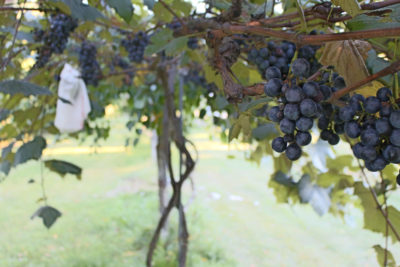
Concord grape
So I also pull off a berry or two to taste. The difference in flavor between just ripe and dead ripe is dramatic. And especially so with my bagged grapes, which can segue to the dramatic stage within their bags without threat of predation by birds and bees.
The variety Concord presents an exception to that last statement; birds don’t like the flavor and leave the berries alone. This means the berries don’t have puncture holes that attract bees and wasps, so they also are not a problem. The deterrent in Concord grapes is the chemical methyl anthranilate, which has been formulated as a spray to keep birds at bay. My wife also doesn’t like Concord.
SOME REFLECTIONS. . . NOT THAT IT’S OVER
/2 Comments/in Gardening, Pests, Vegetables/by Lee ReichFinish Squash
“Zucchini bread is for people who don’t have compost piles.” That’s what I told Deb after she suggested, first ratatouille, and then zucchini bread, as vehicles for our excess zucchini.
Most years I make an early, too large planting of zucchini (about 6 plants), and then, six to eight weeks later, make another sowing of only a couple of plants. The first planting puts enough zucchinis into the freezer for winter, as well as leaving enough for eating. The second planting is to yield an occasional zucchini for fresh eating through summer after plants of that initial planting have succumbed to squash vine borer, cucumber beetles, bacterial wilt, and any of the other maladies that usually do in the plants a few weeks after they begin bearing. Usually and thankfully do in the plants. But not this year.
Almost every time I check that early planting of zucchini, a new fruit has swelled at the end of a vine now trailing beyond its bed beneath stalks of popcorn in an adjacent bed. I feel no obligation to eat zucchini, whether in zucchini bread, ratatouille, or any other concoction.
Where Are the Insects?
In all my decades of gardening, I’ve never experienced a season with so few insect pests. A few Japanese beetles reared their ugly heads back in July; they were the only ones who showed up, except for an occasional straggler. Likewise for bean beetles. Eggplants hosted the few requisite flea beetles, but never enough for concern. (I did spray a few times with horticultural oil; judging from other gardeners’ flea beetle-less experiences this year, doubt that the effect was from the oil.)
Cabbageworms, always requiring some late summer action on my part in the past in the form of one or two sprays of the biological insecticide Bacillus thurengiensis, have let me occupy that time with other things.
Spotted wing drosophila, known non-affectionately as SWD, showed up, as usual, in sufficient numbers in early August to warrant a spray of spinosad, an extract from a naturally-occuring bacteria found in the soil of a defunct rum factory in the Virgin Islands. That one spray, along with some experimental traps from Cornell, was sufficient to keep the buggers from using my blueberries as nurseries in which to raise their young.
As is so often the case with complex systems, in this case involving the vagaries of this season’s weather, the biology and the chemical and physical make-up of the soil, interactions between garden plants as well as between garden plants and weeds, timing of plantings . . . what I’m trying to say is that I have no idea why the year was so auspicious, as far as insects.
Here Are the Diseases
That was insects. Diseases are another story. Don’t look at my tomato plants.
The tomato plants started the season neatly and decoratively trained as single stems up bamboo poles, soon clothing those poles in lush, green leaves and red or orange tomatoes. Now? Stems are pretty much bare from ground level up a couple of feet, with some shriveled, brown remnants of leaves dangling downwards. The disease is not fusarium or verticillium, to which so many modern tomato varieties are touted for being resistant.
The affliction is leaf spot disease, which is actually one or more of three diseases: early blight, septoria leaf spot, and/or late blight. The worst of the three is late blight, which makes us gardeners and farmers especially nervous after a severe outbreak ravaged a large swath of the Northeast a few years ago. Air currents and humidity have not been favorable this year for late blight to hitchhike up from the South, where it overwinters, and any that might have reached here couldn’t get footholds with this season’s hot, dry weather.
Thorough cleanup of old leaves and stems, which house early blight and septoria leaf spot through the winter, and planting tomatoes where they haven’t been plant for the previous two years, was supposed to keep these diseases in check. Perhaps it did, but not enough.
I have two vegetable gardens, and next year I’ll plant tomatoes in the one that housed no tomatoes for the past couple of years, putting more distance between overwintering disease spores and my plants. Clean up and distance should also quell one other disease, anthracnose, responsible for sunken, rotting areas that develop on some of the fruits.
Diseases notwithstanding, plenty of glass jars filled either with sparkling red, canned tomatoes and dull red, dried tomatoes line shelves to bring some essence of summer into through the dark months ahead.
Pepper Heaven
Tomatoes may be the essence of summer for their ubiquity in gardens; for me, though, ripe, red peppers more represent a summery flavor. My peppers rarely experience insect or disease problems. The challenge, this far north, is ripe, red peppers in abundance.
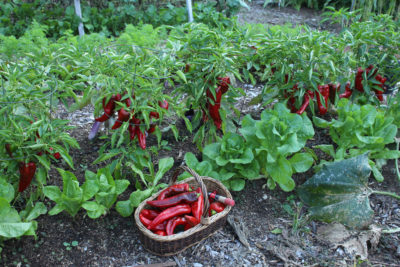
Italian Sweet peppers
My favorite variety for flavor, earliness, and productivity, especially this far north, is Italian Sweet. I put in many plants this past spring, and the harvest is prolific.
Unfortunately, dried or frozen peppers offer only wan hints of the fresh peppers’ summery flavor and texture.
BACTERIA AND FUNGI, AND GRAPES, OH MY
/7 Comments/in Fruit, Gardening, Pests/by Lee ReichUpcoming Fall Fruit Workshop
See web page https://leereich.com/workshops for details.
The River Runs Green
Crossing the bridge over the Wallkill River on my way home, I glance to my right to admire the river itself. What a beautiful color it has turned, a bright turquoise. Ponds I pass also have taken on this bright complexion, for which we can thank, or curse, organisms known as blue-green algae (heretofore referred to as BGA).
Algae, they are not, though. BGA are bacteria known as cyanobacteria. “Algae” generally refers to eukaryotes, organisms with distinct nucleii and specialized organelles. BGA are prokaryotes, lacking such features.
BGA can be toxic, which is good reason to curse them. Drinking or swimming in contaminated waters can cause problems to humans and other animals, including dogs, who seem to be otherwise able to drink almost any water without ill effect. The “cyan” in the name and the criminal cyanotoxins are not at all related to cyanide. The name come from “cyan,” which is the color blue-green.
Many kinds of BGA are found throughout the world, often in extreme conditions. Not all produce cyanotoxins; some produce them only under certain conditions. Not all are even blue-green; the Red Sea gets its color from Trichodesmium erythraeum, a species of BGA. Certain conditions cause “blooms,” such as those I was admiring in the river and ponds. Here, it’s probably a combination of relatively dry conditions resulting in shallow and calm waters along with the usual influx of nutrients, mostly phosphorus and mostly from farms, septic systems, and lawns.
BGA are photosynthetic organisms, just like plants, imbibing carbon dioxide during the day and spewing out oxygen. These primitive organisms, “in the beginning,” were important for oxygenizing the Earth’s atmosphere, thus stimulating biodiversity. We could praise them for sequestering carbon.
Agriculturally, some cyanobacteria are important because they can convert atmospheric nitrogen into forms of nitrogen that plants can use. Although these cyanobacteria are especially important for maintaining fertility of rice paddies, they are present, to some degree, in virtually all soils. Some research even points to benefits of inoculating soils with these organisms.
Bags vs. Fungi
So now I’m home, my head out of the soil, and admiring my grape vines. The dry weather has been almost as good for the grapes as it has been for the cyanobacteria. Dry weather minimizes grape diseases and abundant sunlight puts flavor and sweetness into the berries. With annual applications of mulch around the grapes and their far reaching roots, I never worry about my established vines being thirsty.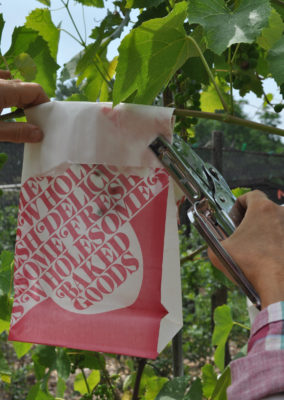
Back in early summer, we went to the trouble of affixing paper “delicatessen” bags around 100 bunches. Now is the payoff. Peeling back the paper usually reveals perfect, full, bloom-dusted bunches of especially delectable grapes. “Especially delectable” because I can let these protected bunches hang longer on the vines than unbagged bunches, which do have some disease and are prey to bees, wasps, and birds. These bagged grapes get dead ripe before being harvested.
The bagging isn’t really all that troublesome. We just select downward hanging bunches, made easier because I train fruiting canes horizontally across a 5-wire, flat trellis, and remove any tendrils or leaves opposite the bunches. After making a slit down each side of a bag, the slitted opening is slid up the cane on either side of the bunch, the top of the bag is folded over, and then the flap stapled down on either side — well worth the minute or so it takes from selection to finish bagging a bunch.
Grapes to Keep
With many varieties of established grapevines, I can cut down any whose flavor is not up to snuff or that don’t produce well without having to bemoan waiting for new ones to start bearing. The “keepers” tide me over. Variety choice is somewhat limited here because of winter cold and because cooler, damp air collects in this valley, promoting disease, abetted by inoculum from all the wild grape vines grappling high into neighboring trees along the forest edge.
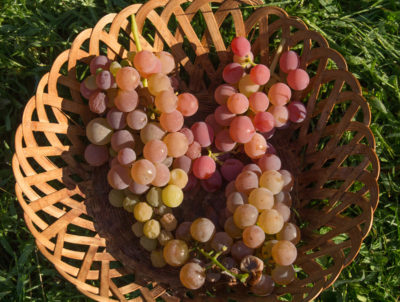
Glenora and Vanessa seedless grapes
I’ll be doing a Henry IVth on Mars and Concord.
Some of my current favorite varieties are Vanessa, Somerset Seedless, and Glenora, all seedless varieties. Of the three, Glenora has the best flavor, Vanessa the best texture, but they’re all very good. Some of my favorite seeded varieties are Alden, whose corpulent berries hang in large bunches, and Brianna, which isn’t quite ripe yet, but every year has rewarded us with foxy-flavored, pale green berries.
Still to come for this season are Edelweiss, which has a rich, very foxy flavor but has not been very productive the last few years, and Brianna, with its own rich flavor not so dependent on foxiness.
A few more years of tasting and watching will dictate whether New York Muscat, Cayuga White, Bertille Seyve 2758, Lorelei, Reliance, Swenson White, and Wapanuka keep their home here. They’re all good grapes, but why grow good grapes when I could grow great grapes from among the 5,000 or so varieties (not all adaptable here, of course)?
(That “foxy” flavor I kept referring to is characteristic of many American grapes, and is typified by the variety Concord. No one is sure how “foxy came to describe that flavor.)

